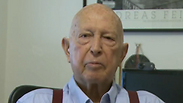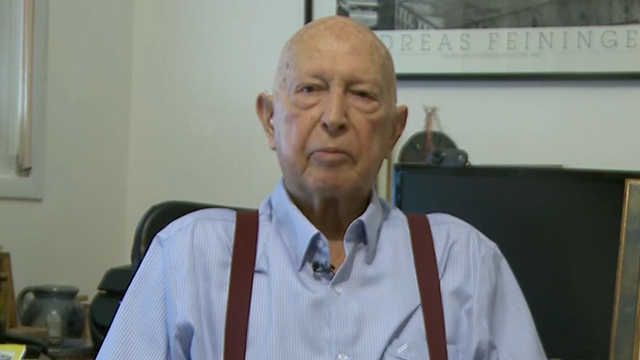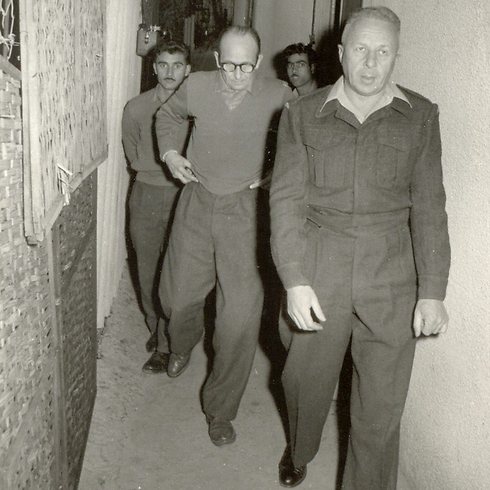
The life story of Holocaust survivor Micha Maor, 84, is interwoven with that of the State of Israel. He dreamed of being a photographer, but would be remembered mainly as the man who photographed the documents that helped convict Adolf Eichmann.
"There are many Holocaust survivors who have contributed a great deal to the State of Israel, and I am happy that I am one of them," Maor told Ynet.
Maor was born in Germany in 1933. During the Holocaust, he was imprisoned in a concentration camp in Yugoslavia and immigrated to Israel immediately after the war, in June 1945.
After ten days in the Atlit camp, he began a military career, eventually serving under Rafael "Raful" Eitan. After his release from the army, he decided to study photography in Germany. But then, the Mossad changed his life.
"The state recruited him to the Mossad and assigned him a very interesting task: to stealthily access the office of Dr. Fritz Bauer, who was the District Attorney in Hessen, Germany," said Dr. Tal Misgav, a historian of the Border Police and commander of the Military Museum. "He photographed documents related to Eichmann and then he was sent again on the same assignment. The additional documents he photographed were those that made it possible to unequivocally prove Eichmann's involvement in the Final Solution, without which it could not be fully proven that it was Eichmann."
Maor said that at first, he wasn't aware he had been recruited to the Mossad when he was in Germany, since they suggested that he first work in the photography laboratory, which he later ran. "I ran a few errands and I still didn't know it was the Mossad," he recalled.
"One day, in 1960, the director-general of the Mossad who was based in Germany called me and assigned me a task—to infiltrate the German prosecutor's office in Frankfurt and the office of Dr. Fritz Bauer, who was the district attorney."
The director general described the room to Maor in meticulous detail. "He told me that I would find two binders on his desk, which I had to photograph. I didn't exactly know what the mission was… I took a train to Frankfurt with a James Bond briefcase equipped with a Leica camera, a flash, flashlight, film rolls, etc. Even though there was no advance preparation, I was a paratrooper officer, trained in weapons and in Krav Maga. I was an athlete, and I wasn't afraid of anything. "
Maor entered the attorney's office, where he began to photocopy the documents. He didn't know what he was copying but he noticed Eichmann's picture. "I didn't know it was him, but it was written, 'Obersturmmann Fuhrer Adolf Eichmann.' Anybody else who had gone through the Holocaust … would have collapsed right there. I didn't read, I just took pictures. I encountered many swastikas, many signatures of infamous SS officers. As far as I recall, I also had a document by Adolf Hitler himself. Imagine me, a Jew, a Holocaust survivor, touching an authentic Hitler document, touching and photographing."
After about fifteen minutes, Maor sensed someone at the door. "It was the maid who stopped by the door. I saw the silhouette of her shoes. Those were the longest seconds of my life. I immediately packed up my equipment. It was quiet. And ten seconds later, she went on her way. I returned by train to Cologne, and that same night I began to develop the pictures I had taken. Only then did I understand the magnitude of the mission."
Maor mailed the photographs via a diplomatic post office, and he felt that something was about to happen. "A week or two later, Eichmann was brought to Israel, and then it was clear that these documents would be living testimony written by the Nazis for Eichmann's trial," he said. "I still live it, so much so that when this issue came to light, I recounted (the entire story) to the Germans … and it also appeared in the newspaper Der Spiegel … it amazed them that a Jew had the courage to go into the District Attorney's Office and do this job."
Maor returned to Israel and joined the security apparatus of the young state. He re-enlisted into the IDF and even served in the Military Intelligence's General Staff. Maor was the one who established the Border Police intelligence unit in Israel and to this day, he is considered one of the forefathers of the Border Police intelligence.
On the occasion of Holocaust Remembrance Day, Maor decided to convey a personal message: "When I lecture at the schools in east Germany every year about the Holocaust, I do not lecture on my suffering as a child, but rather tell the story of a person who left the inferno and what he contributed to the State of Israel… To this day, at the age of 84, I am still active with the International Police Association (IPA)… the message is that there are many Holocaust survivors who have contributed a great deal to the State of Israel and I am happy to be one of them."



















